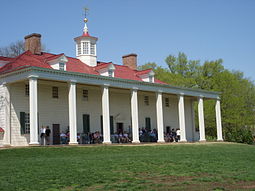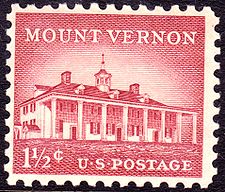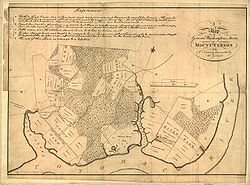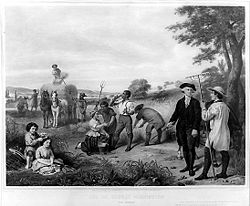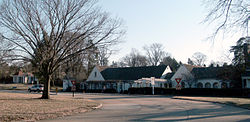- Mount Vernon
-
- This is about the George Washington residence. For other uses, see Mount Vernon (disambiguation).
Mount Vernon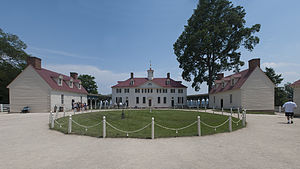 Mount Vernon Estate
Mount Vernon EstateLocation: Mount Vernon, Fairfax County, Virginia Nearest city: Alexandria, VA Built: 1757 Architect: George Washington Architectural style: Georgian Governing body: Mount Vernon Ladies' Association NRHP Reference#: 66000833 Significant dates Added to NRHP: December 19, 1960[1] Designated NHL: December 19, 1960[2] Mount Vernon, located near Alexandria, Virginia, was the plantation home of the first President of the United States, George Washington. The mansion is built of wood in neoclassical Georgian architectural style, and the estate is located on the banks of the Potomac River.
Mount Vernon was designated a National Historic Landmark in 1960 and is listed on the National Register of Historic Places. It is owned and maintained in trust by The Mount Vernon Ladies' Association and is open every day of the year.
Contents
Name
When Augustine Washington owned the estate, it was known as Little Hunting Creek Plantation after the nearby Little Hunting Creek. Lawrence Washington, George's older half-brother, inherited the estate and changed its name to Mount Vernon in honor of Vice Admiral Edward Vernon famed for the War of Jenkin's Ear and capture of Portobelo, Colón. Vernon had been Lawrence's commanding officer in the British Navy, and Lawrence greatly admired him. When George Washington inherited the property he retained the name.[3]
History
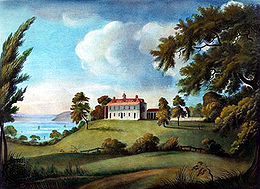 Mount Vernon, aquatint by Francis Jukes, 1800
Mount Vernon, aquatint by Francis Jukes, 1800
The early history of the estate at Little Hunting Creek is separate from that of the home, which wasn't occupied until 1743. In 1674, John Washington and Nicholas Spencer came into possession of the land from which Mount Vernon plantation would be carved.[4] The successful patent on the acreage was due largely to Spencer, who acted as agent for his cousin Thomas Colepeper, 2nd Baron Colepeper,[5] the English landowner who controlled the Northern Neck of Virginia, in which the tract lay.[6] When John Washington died in 1677, his son Lawrence, George Washington's grandfather, inherited his father's stake in the property. In 1690, he agreed to formally divide the estimated 5,000 acre (20 km2) estate with the heirs of Nicholas Spencer, who died the previous year. The Spencers took the larger southern half bordering Dogue Creek (originally called "Epsewasson") in the September 1674 land grant from Lord Culpeper, after the former name of the creek), leaving the Washingtons the portion along Little Hunting Creek. (The Spencer heirs paid Lawrence Washington 2,500 lb (1,100 kg) of tobacco as compensation for their choice.)[7]
Upon Lawrence Washington's death, he left the property to his daughter, Mildred. In 1726, at the urging of her brother Augustine Washington (George Washington's father), Mildred sold him the Potomac River estate. In 1735, Augustine Washington moved his young, second family to the estate, settling into a 'Quarter' alongside Little Hunting Creek. In 1738, Augustine recalled his eldest son Lawrence (George's half-brother) home from The Appleby School in England and set him up on the family's Little Hunting Creek tobacco plantation, thereby allowing Augustine to move his family back to Fredericksburg at the end of 1739.
In 1739, Lawrence, having reached his majority (age 21), began buying up parcels of land from the adjoining Spencer tract, beginning with the land around the Grist Mill on Dogue Creek. In the summer of 1740, Lawrence received a coveted officer's commission in the Regular British Army, and made preparations to go off to war in the Caribbean with the newly formed American Regiment. Part of his preparations included ensuring his father had legal control over the tracts Lawrence purchased from Spencer. While he was away at war (the War of Jenkins' Ear, 1739–1743), Lawrence wrote to his father from Jamaica in May 1741, that, should he survive the war, he intended to make his home in the town of Fredericksburg, building a town home on one of the three lots he owned there.
At this same time, the Spencer family was in a legal dispute over additional land sales to Lawrence's neighbors. To adjudicate the boundary line dispute, a general court for Prince William County ordered a new survey of the entire 5,000 acre (20 km²) Washington-Spencer land grant. The surviving map of that 1741 survey, a plat, by County Surveyor Robert Brooke, revealed the estate had been grossly mis-measured in April 1669, and it contained only about 4,200 acres (17 km²), not the 5,000 acres (20 km2) conveyed in the 1674 land grant. The gross mis-measurement can be attributed to the fact that the property was bounded on three sides by water, and that neither the River nor the two creeks had regular shorelines. Pursuant to the Culpeper land grant, the original 1669 surveyor was charged with estimating an area of 5,000 acres (20 km²) and then blazing a straight-line "back" boundary along a tree line between the winding courses of Dogue Run and Little Hunting Creek.
More importantly, this surviving May 1741 property survey by Brooke reveals that the location of the present-day mansion house was then vacant, with the Washingtons depicted as having their Quarter alongside Little Hunting Creek (as was shown on a similar, larger-scale Potomac River survey of 1738).
Upon receiving word of Lawrence's intent to live in Fredericksburg, Augustine Washington appears to have undertaken to erect a modest farm house on the vacant bluff overlooking the Potomac River (where the mansion house now sits) in 1741-42. It is estimated Lawrence received news of his father's plans in late 1741, while at Jamaica, and presumably wrote back instructing his father to call the new home "Mount Vernon" in honor of Captain Lawrence Washington's commanding officer, Vice Admiral Edward Vernon (then regarded as the greatest military hero of the age in Britain.) In early August 1742, the place name "Mount Vernon" first appears in a surviving letter, penned by Lawrence's Potomac River neighbor, William Fairfax, of Belvoir. Lawrence Washington returned from the war in late 1742, buried his father in April 1743, married into the Fairfax family and took up residence at his "Mount Vernon" in July 1743. By the late 1740s Lawrence undertook an expansion of the home Augustine built for him.
Upon Lawrence's untimely death in July 1752, his will provided that his widow should own a life estate in Mount Vernon, with the remainder interest falling to Lawrence's beloved half-brother, George. George Washington was already living at Mount Vernon and probably managing the plantation. Lawrence's widow, Anne Fairfax, promptly remarried into the Lee family and moved out. Upon the death of Anne and Lawrence's only surviving child in 1754, George, as executor of his brother's estate, arranged to lease "Mount Vernon" that December. Later, he bought his sister-in-law's life estate and became owner of the property. In 1757, George began the first of two major additions and improvements to the home. The second expansion was begun shortly before the outbreak of the Revoluntionary War. On those occasions he entirely rebuilt the main house atop the original foundations, doubling its size each time. The great majority of the work was performed by slaves and artisans. While he twice rebuilt the home, George never changed its patriotic British name.
Though no architect is known to have designed Mount Vernon, some attribute the design to John Ariss (1725–1799), a prominent Virginia architect who designed Paynes Church in Fairfax County (now destroyed) and likely Mount Airy, Richmond County, Virginia. A friend of George Washington, to whom he leased his home, Ariss was, in an interesting coincidence, the great-grandson of Col. Nicholas Spencer, the original patentee of Mount Vernon with the Washingtons.[8] Other sources credit Col. Richard Blackburn, who also designed Rippon Lodge in Prince William County and the first Falls Church.[9][10] His granddaughter Anne married Bushrod Washington and is interred at the Washingtons' tomb on the grounds.
Upon Anne Fairfax Washington Lee's death in 1761, George was the only claimant to the Mount Vernon estate. He had already started purchasing surrounding parcels of land in the late 1750s, and continued adding to the estate well into the 1780s.[11] From 1759 until the Revolutionary War, Washington, who at the time aspired to become a prominent agriculturist, operated the estate as five separate farms. He took a scientific approach to farming and kept extensive and meticulous records of both labor and results.
In a letter dated September 20, 1765, Washington writes about receiving poor returns for his tobacco production:
Can it be otherwise than a little mortifying then to find, that we, who raise none but Sweetscented Tobacco, and endeavour I may venture to add, to be careful in the management of it, however we fail in the execution, and who by a close and fixed corrispondance with you, contribute so largely to the dispatch of your Ships in this Country shoud meet with such unprofitable returns?[12]
In the same letter he asks about the prices of flax and hemp, with a view to their production:
In order thereto you woud do me a singular favour in advising of the general price one might expect for good Hemp in your Port watered and prepared according to Act of Parliament, with an estimate of the freight, and all other Incident charges pr. Tonn that I may form some Idea of the profits resulting from the growth. I shoud be very glad to know at the sametime how rough and undressd Flax has generally, and may probably sell; for this year I have made an Essay in both, and altho I suffer pretty considerably by the attempt, owing principally to the severity of the Drougth, and my inexperience in the management I am not altogether discouraged from a further prosecution of the Scheme provided I find the Sales with you are not clogd with too much difficulty and expence.
By 1766, Washington completely ended tobacco growing at Mount Vernon, instead raising wheat, corn, and other grains. Besides hemp and flax, he experimented with 60 other crops. Washington built a gristmill which produced cornmeal and flour for export and ground neighbors' grain as well. He similarly sold the services of the estate's looms and blacksmith, and built a small fishing fleet that let Mount Vernon also export fish. Because other crops were much less labor-intensive than tobacco and Washington refused to break up families for sale the estate always had too many slaves, so he hired skilled indentured servants from Europe to train them for service on and off the estate.[13]:157,196-199
Following his service in the war, Washington returned to Mount Vernon and in 1785-1786 spent a great deal of effort improving the landscaping of the estate. It is estimated that during his two terms as President of the United States (1789–1797) Washington spent 434 days in residence at Mount Vernon. After his presidency, Washington tended to repairs to the buildings, socializing, and further gardening. Washington selectively bred sheep and grew various types of crops on the plantation, including flax, hemp, cotton and silk:[14] in 1794 he wrote to the gardener at Mount Vernon advising "[m]ake the most you can of the Indian Hemp seed and sow it everywhere".[15] One of his most successful ventures was the establishment of a distillery in 1797; he briefly became one of the new nation's largest distillers of whiskey.[16]
The remains of George and Martha Washington, as well as other family members, are entombed on the grounds. In accordance with his will, Washington was entombed in a family crypt he had built upon first inheriting the estate. It was in disrepair by 1799, so Washington's will also requested that a new, larger tomb be built. This was not done immediately, but following an attempt to rob the grave, in 1831 a new vault was finally constructed in Washington's desired location.[17] After Washington's death in 1799, plantation ownership passed through a series of relatives who lacked either the will or the means to maintain the property. After trying unsuccessfully for five years to restore the estate, John Augustine Washington offered it for sale in 1848. The Commonwealth of Virginia and United States governments declined to buy the home and estate.
In 1858, the Mount Vernon Ladies' Association of the Union, under the leadership of Ann Pamela Cunningham, acquired the mansion and a portion of the land from Washington's great-grandnephew, John A. Washington, Jr., rescuing it from a state of disrepair and neglect. They paid the final installment of the purchase price of $200,000 (equal to $4,872,593 today) on December 9, 1859, taking possession on February 22, 1860.[18] The estate served as neutral ground for both sides during the American Civil War, although fighting raged across the nearby countryside.
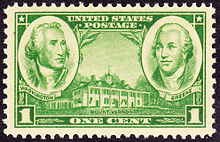 Accurate engraved rendition of Mt. Vernon on a U.S. postage stamp, Army Issue of 1937
Accurate engraved rendition of Mt. Vernon on a U.S. postage stamp, Army Issue of 1937
Mount Vernon was designated a National Historic Landmark on December 19, 1960 and later administratively listed on the National Register of Historic Places.
The mansion has been restored by the Association, independent of the US government, with no tax dollars expended to support the 500-acre (2.0 km2) estate, its educational programs or activities.[19] The restoration is complete with period furniture and decor, and today serves as a popular tourist attraction. The estate is also well known for its exceptional landscaping and ancillary buildings.
Harrison Howell Dodge was appointed as resident superintendent in 1885 and during his 52 years overseeing the estate, he doubled the facility's acreage, improved the grounds and added many historic artifacts to the collections there. Dodge reviewed George Washington's writings about the estate, visited other Colonial-era gardens, and traveled to England to see gardens there dating from the Georgian period. Using this knowledge, Dodge oversaw the restoration of the site and put in place a number of improvements that Washington planned but never implemented.[20]
Charles Wall served as resident superintendent for 39 years starting 1937 after having been assistant superintendent since 1929. During his tenure, Wall oversaw restoration of the home and planted greenery consistent with what was used in the 18th century. In 1974, a campaign he organized was successful in preserving as parkland areas in Maryland across the Potomac River from Mount Vernon, as part of an effort to retain the bucolic vista from the home.[21] His office was the same one used in the 18th century by Washington himself.[22]
The Grounds
The property consists of 500 acres (2.0 km2),[23] with the main buildings, including the house, located near the riverfront. English boxwoods, taken from cuttings sent by Maj. Gen. Henry Lee III "Light Horse Harry" (Governor of Virginia and father of Robert E. Lee), were planted in 1786 by George Washington and now crowd the entry path. The main homestead area is skirted by a carriage road with a large bowling green located in the center. To each side of the green is a garden, contained by a red brick wall. These Colonial Revival gardens[24] grew the household's vegetables, fruit and other perishable items for consumption. The upper garden, located to the north, is bordered by the greenhouse.[25] The Botanical Garden; the Museum, dedicated to the life and death of George Washington is on the grounds and contains George Washington's survey equipment, weapons, and clothing, as well as dentures worn by the first President; ice house; overseers quarters; spinning room; salt house and gardener's house are between the garden and the house.
The lower garden, or southern garden, is skirted by the storehouse and clerk's quarters, smokehouse, wash house, laundry yard, and coach house. A paddock and stable are on the southern border of the garden. The old tomb is located along the river, while the new tomb, containing George and Martha Washington, is located near the fruit garden with the slave burial ground just off this path. A Forest Trail runs along the property, and a George Washington: Pioneer Farmer site, a 4-acre (16,000 m2) working farm that includes a re-creation of Washington's 16-sided treading barn.[26]
The main house is located in the center of these support buildings and was once the hub of all the activity at Mount Vernon. The house has two storys with a hipped roof with dormers. Two large chimneys pierce the roof at either end and a cupola rests in the center of the house. The cupola is topped with a dome and a spire with a gilded dove of peace.[27]
The house was built in phases, as the off-center main door makes evident. The structure once contained the northern portion of the house until it was expanded several times in its history. The house is framed by two covered walkways leading to servants hall on the left and the kitchen to the right. A circular courtyard completes the grand appearance of the house.
Recent development
“ I have no objection to any sober or orderly person's gratifying their curiosity in viewing the buildings, Gardens, &ca. about Mount Vernon. ” —George Washington, letter to William Pearce (November 23, 1794)
On March 30, 2007, Washington’s Mount Vernon estate officially opened a reconstruction of Washington’s distillery. This fully functional replica received special legislation from the Virginia General Assembly to produce up to 5,000 USgal (19,000 l) of whiskey annually, for sale only at the Mount Vernon gift shop. The construction of this operational distillery cost $2.1 M and is located on the exact site of Washington's original distillery, a short distance from his mansion on the Potomac River. Frank Coleman, spokesman for the Distilled Spirits Council that funded the reconstruction, said the distillery “will become the equivalent of a national distillery museum” and serve as a gateway to the American Whiskey Trail.[28]
In October 2006, following a $110 million fund raising campaign, two new buildings designed by GWWO, Inc./Architects were opened as venues for additional background on George Washington and the American Revolution.
On November 7, 2007, President George W. Bush hosted French President Nicolas Sarkozy for a general press conference on the front lawn of Mt. Vernon following Sarkozy's address to a joint session of Congress earlier the same day, briefing the press on the two leaders' earlier meetings.[29]
Notes
- ^ ["National[dead link] Register Information System on page on Mount Vernon."]. National Register of Historic Places. National Park Service. [http://www.nr.nps.gov/iwisapi/explorer.dll?IWS_SCHEMA=NRIS1&IWS_LOGIN=1&IWS_REPORT=100000046.[dead link]
- ^ "Mount Vernon". National Historic Landmark summary listing. National Park Service. http://tps.cr.nps.gov/nhl/detail.cfm?ResourceId=636&ResourceType=Building. Retrieved 2008-06-27.
- ^ "Why is George Washington's Estate called Mount Vernon?" Mount Vernon Ladies' Association, accessed 1 May 2009
- ^ The deed conveying the grant of Mount Vernon, then in Stafford County, to Washington and Spencer was dated March 1, 1677, and was signed by 'Tho. Culpepper,' the original proprietor of the Northern Neck, from whom the proprietorship devolved to his eventual heir Thomas Fairfax, 6th Lord Fairfax of Cameron.
- ^ Dalzell, Jr., Robert F.; Dalzell, Lee Baldwin (2000). George Washington's Mount Vernon. Oxford University Press. pp. 22–23. ISBN 0195136284. http://books.google.com/?id=kKpIGzLLo0YC&dq=%22nicholas+spencer%22+mount+vernon
- ^ Encyclopedia of Virginia Biography, Lyon Gardiner Tyler, Vol. I, Lewis Historical Publishing Company, New York, 1915
- ^ George Washington's Mount Vernon, Robert F. Dalzell, Robert F. Dalzell, Jr., Lee Baldwin Dalzell, Oxford University Press, 2000
- ^ Architecture and Town Planning in Colonial North America, James D. Kornwolf, Georgiana Wallis Kornwolf, Johns Hopkins University Press, Baltimore, 2002
- ^ Writers' Program of the Work Projects Administration in the State of Virginia. VIRGINIA A Guide To The Old Dominion. American Guide Series. New York: Oxford University Press.
- ^ Hayden, H.E.. Virginia Genealogies.
- ^ "The Growth of Mount Vernon 1754-1786". The Papers of George Washington. http://gwpapers.virginia.edu/maps/mtvernon/growth.html.
- ^ "George Washington to Robert Cary & Company, September 20, 1765, Account Book 1". The Writings of George Washington from the Original Manuscript Sources, 1745-1799. John C. Fitzpatrick, Editor.. The George Washington Papers at the Library of Congress, 1741-1799. http://memory.loc.gov/cgi-bin/query/r?ammem/mgw:@field(DOCID+@lit(gw020296)). Retrieved 2009-03-06.
- ^ Chernow, Ron (2010). Washington: A Life. The Penguin Press. ISBN 978-1-101-44418-4.
- ^ "George Washington's Mount Vernon - Explore Mount Vernon". George Washington's Mount Vernon Estate and Gardens. http://www.mountvernon.org/visit/plan/index.cfm/pid/293/. Retrieved 9 January 2009. "Textile production was vital to achieving self-sufficiency at Mount Vernon. Washington practiced selective breeding of sheep to produce better quality wool, grew flax and hemp for making linen cloth and rope, and experimented with cultivating cotton and silk. Mount Vernon"
- ^ The Colorado Hemp Production Act of 1995: Farms and Forests without Marijuana[dead link] by Thomas J. Ballanco quotes this on its first page. The footnote used states Ballanco finds this quote reprinted in Chris Conrad's 1993 book, Hemp, Lifeline to the Future.
- ^ "George Washington's Distillery". Distilled Spirits Council of the United States. 2007. http://www.discus.org/heritage/washington.asp. Retrieved 2011-08-08.
- ^ "The Will of George Washington". Alderman Library-University of Virginia. 7 July 1799. http://gwpapers.virginia.edu/documents/will/text.html. Retrieved 2011-08-08.
- ^ "The Formation of the Mount Vernon Ladies' Association and the Dramatic Rescue of George Washington's Estate". Mount Vernon Ladies' Association. http://www.mountvernon.org/visit/plan/index.cfm/pid/809/. Retrieved 2008-02-28.
- ^ "Exploring Mount Vernon". Smithsonian Magazine (Smithsonian.com). November 1, 2006. http://www.smithsonianmag.com/history-archaeology/exploring_mount_vernon.html. Retrieved 2008-02-28.
- ^ Staff (21 May 1937). "Col. Harrison Dodge, Mt. Vernon Custodian; Superintendent of Washington's Home Since 1885--Made Many Improvements". The New York Times (NYTimes.com). http://select.nytimes.com/gst/abstract.html?res=F50B1EF93A5E177A93C3AB178ED85F438385F9. Retrieved 2010-07-24.
- ^ Robert McG. Thomas, Jr. (May 5, 1995). "Charles Wall, 91, Long Director Of George Washington's Home". The New York Times (NYTimes.com). http://www.nytimes.com/1995/05/05/obituaries/charles-wall-91-long-director-of-george-washington-s-home.html. Retrieved July 23, 2010.
- ^ Barnes, Bart. "Former Master of Mt. Vernon Charles Cecil Wall Dies at 91", The Washington Post, May 4, 1995. Accessed July 23, 2010.
- ^ "Mount Vernon Fact Sheet". mountvernon.com. 2011. http://www.mountvernon.org/pressroom/index.cfm/fuseaction/view/pid/803. Retrieved 2011-08-08.
- ^ Griswold and Foley, p. 124.
- ^ "Gardens". Mountvernon.org. http://www.mountvernon.org/learn/explore_mv/index.cfm/ss/30/. Retrieved 2011-08-08.
- ^ "Sixteen-Sided Barn". Mountvernon.org. http://www.mountvernon.org/learn/explore_mv/index.cfm/sss/76/. Retrieved 2011-08-08.
- ^ "History of Mount Vernon". Mountvernon.com. http://www.mountvernon.org/learn/explore_mv/index.cfm/ss/27/. Retrieved 2011-08-08.
- ^ Barakat, Matthew (March 31, 2007). "Replica of distillery of Washington Opens". The Navy Times (navytimes.com). http://www.navytimes.com/news/2007/03/ap_washingtonwhiskey_070331/. Retrieved 2007-04-01.
- ^ James Gerstenzang (8 November 2007). "Bush, Sarkozy stand on common ground". Los Angeles Times (LATimes.com). http://articles.latimes.com/2007/nov/08/nation/na-sarkozy8. Retrieved 2011-08-08.
References
- Dalzell, Jr., Robert F. and Balzell, Lee Baldwin. George Washington's Mount Vernon: At Home in Revolutionary America. New York: Oxford University Press, 1998.
- Griswold, Mac and Foley, Roger. Washington's Gardens at Mount Vernon: Landscape of the Inner Man. Boston, Mass.: Houghton Mifflin, 1999.
- Wilstach, Paul. Mount Vernon: Washington's Home and the Nation's Shrine. Indianapolis: The Bobbs-Merrill Company, 1918.
- Virginia: A Guide to the Old Dominion. New York: Oxford University Press, 1940.
External links
- Official website of Mount Vernon
- National Historic Landmark: Mount Vernon
- National Shrine: Bringing George Washington Back to Life
Coordinates: 38°42′28″N 77°05′10″W / 38.7079°N 77.0861°W
The Washington family First generation Lawrence Washington (1602–1653)Second generation Third generation Lawrence Washington (1659–1698)Fourth generation Fifth generation Lawrence Washington (1718–1752) • Augustine Washington, Jr. • George Washington • Betty Washington Lewis • Samuel Washington • John Augustine Washington • Charles WashingtonSixth generation Seventh generation John Thornton Augustine Washington • George Corbin WashingtonEighth generation Ninth generation George Corbin Washington • James Barroll Washington • Mary Ann Washington • Eliza Ridgeley Washington • Betty Lewis Washington • William De Hertbrun WashingtonTenth generation William Lanier WashingtonWashington family residences: Abingdon • Arlington House • Beall-Air • Blakeley • Cedar Lawn • Claymont Court • Ferry Farm • George Washington Birthplace National Monument • Happy Retreat • Harewood • Kenmore • Mary Washington House • Mount Vernon • Richwood Hall • Ridgedale • Rising Sun Tavern • River Farm • Sulgrave • Washington Old HallFairfax County, Virginia Administration Fairfax County Public Schools · Fairfax County Board of Supervisors · Fairfax County Park Authority · Fairfax County Economic Development Authority · Fairfax County Public Library · Fairfax County Fire and Rescue Department · Fairfax County Police Department · Fairfax County Sheriff's OfficeOrganizations Landmarks Fairfax County Government Center · Wolf Trap National Park for the Performing Arts · Inova Fairfax Hospital · Mount Vernon · Gunston Hall · Tysons Corner Center · Washington & Old Dominion Railroad Regional Park · Great Falls Park · Steven F. Udvar-Hazy Center · Washington and Old Dominion Railroad · Fort BelvoirTransportation Culture BattlesEventsEducation U.S. National Register of Historic Places Topics Lists by states Alabama • Alaska • Arizona • Arkansas • California • Colorado • Connecticut • Delaware • Florida • Georgia • Hawaii • Idaho • Illinois • Indiana • Iowa • Kansas • Kentucky • Louisiana • Maine • Maryland • Massachusetts • Michigan • Minnesota • Mississippi • Missouri • Montana • Nebraska • Nevada • New Hampshire • New Jersey • New Mexico • New York • North Carolina • North Dakota • Ohio • Oklahoma • Oregon • Pennsylvania • Rhode Island • South Carolina • South Dakota • Tennessee • Texas • Utah • Vermont • Virginia • Washington • West Virginia • Wisconsin • WyomingLists by territories Lists by associated states Other Categories:- NRHP articles with dead external links
- Alexandria, Virginia
- Archaeological sites in Virginia
- George Washington
- National Historic Landmarks in Virginia
- Presidential homes in the United States
- Washington family residences
- Houses completed in 1757
- Historic house museums in Virginia
- Burial sites of Presidents of the United States
- Plantations in Virginia
- Museums in Fairfax County, Virginia
- Presidential museums in Virginia
- Georgian architecture in Virginia
- Farm museums in Virginia
- Houses in Fairfax County, Virginia
- Smithsonian Institution affiliates
Wikimedia Foundation. 2010.

